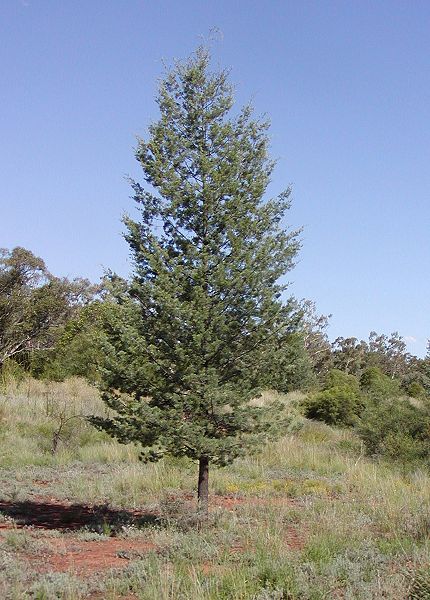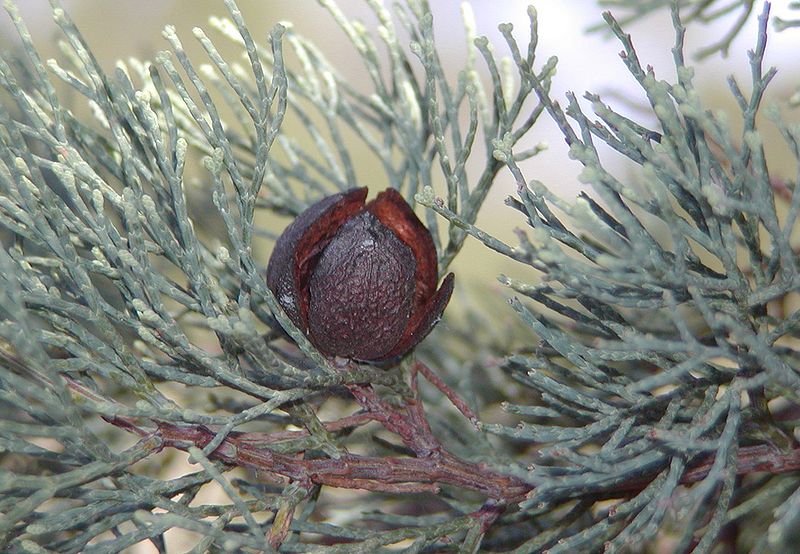 |
|
http://www.flickr.com/photos/63319497@N00/ |
 |
| http://commons.wikimedia.org/wiki/User:MPF |
Translate this page:
Summary
Physical Characteristics

 Callitris columellaris is an evergreen Tree growing to 20 m (65ft 7in).
Callitris columellaris is an evergreen Tree growing to 20 m (65ft 7in).
See above for USDA hardiness. It is hardy to UK zone 10. It is in leaf all year. The species is monoecious (individual flowers are either male or female, but both sexes can be found on the same plant).
Suitable for: light (sandy) and medium (loamy) soils and prefers well-drained soil. Suitable pH: mildly acid, neutral and basic (mildly alkaline) soils and can grow in very alkaline and saline soils.
It cannot grow in the shade. It prefers dry or moist soil and can tolerate drought.
UK Hardiness Map
US Hardiness Map
Synonyms
C. arenosa. C. glauca.
Plant Habitats
Woodland Garden Secondary; Dappled Shade;
Edible Uses
References More on Edible Uses
Medicinal Uses
Plants For A Future can not take any responsibility for any adverse effects from the use of plants. Always seek advice from a professional before using a plant medicinally.
None known
References More on Medicinal Uses
The Bookshop: Edible Plant Books
Our Latest books on Perennial Plants For Food Forests and Permaculture Gardens in paperback or digital formats.

Edible Tropical Plants
Food Forest Plants for Hotter Conditions: 250+ Plants For Tropical Food Forests & Permaculture Gardens.
More

Edible Temperate Plants
Plants for Your Food Forest: 500 Plants for Temperate Food Forests & Permaculture Gardens.
More

More Books
PFAF have eight books available in paperback and digital formats. Browse the shop for more information.
Shop Now
Other Uses
Fuel Resin Tannin Wood
A resin obtained from the stumps of felled trees or the cut logs is used as a coating for pills[152]. The bark contains 11 - 23% dry weight of tannin[1, 156]. Wood - resinous, very aromatic, very durable, brittle, very flammable, hard, close grained. Used for construction. furniture making, cabinet making, fencing, ship building etc[1, 152, 167].
Special Uses
References More on Other Uses
Cultivation details
Prefers a dry sandy coastal soil in full sun, succeeding in saline soils[200]. A very drought tolerant plant once established[81, 200]. This species can tolerate temperatures down to at least -7°c in Australian gardens[157] but this cannot be translated directly to British gardens due to our cooler summers and longer, colder and wetter winters. Some reports say that plants can succeed outdoors in the very mildest areas of this country[1, 81] but another report places this species in hardiness zone 10, which would mean that it is not frost tolerant and could only be grown with winter protection[200]. The plants are highly inflammable and are usually killed by forest fires. However, they store their seeds in unopened cones on the tree for many years, these seeds are released after a fire and then germinate freely[200].
References Carbon Farming Information and Carbon Sequestration Information
Temperature Converter
Type a value in the Celsius field to convert the value to Fahrenheit:
Fahrenheit:
The PFAF Bookshop
Plants For A Future have a number of books available in paperback and digital form. Book titles include Edible Plants, Edible Perennials, Edible Trees,Edible Shrubs, Woodland Gardening, and Temperate Food Forest Plants. Our new book is Food Forest Plants For Hotter Conditions (Tropical and Sub-Tropical).
Shop Now
Plant Propagation
Seed - does not require stratification, germinating at any time of the year if it becomes moist[200]. Sow in early spring in a greenhouse. When large enough to handle, prick the seedlings out into individual pots and grow them on in the greenhouse for at least their first winter, planting them out into their permanent positions in late spring or early summer, after the last expected frosts.
Other Names
If available other names are mentioned here
Native Range
AUSTRALASIA: Australia (New South Wales, Queensland, South Australia, Victoria, Western Australia, Australian Capital Territory, Northern Territory, Ashmore and Cartier Islands)
Weed Potential
Right plant wrong place. We are currently updating this section.
Please note that a plant may be invasive in one area but may not in your area so it's worth checking.
Conservation Status
IUCN Red List of Threatened Plants Status :

Growth: S = slow M = medium F = fast. Soil: L = light (sandy) M = medium H = heavy (clay). pH: A = acid N = neutral B = basic (alkaline). Shade: F = full shade S = semi-shade N = no shade. Moisture: D = dry M = Moist We = wet Wa = water.
Now available:
Food Forest Plants for Mediterranean Conditions
350+ Perennial Plants For Mediterranean and Drier Food Forests and Permaculture Gardens.
[Paperback and eBook]
This is the third in Plants For A Future's series of plant guides for food forests tailored to
specific climate zones. Following volumes on temperate and tropical ecosystems, this book focuses
on species suited to Mediterranean conditions—regions with hot, dry summers and cool, wet winters,
often facing the added challenge of climate change.
Read More
Expert comment
Author
F.Muell.
Botanical References
1200
Links / References
For a list of references used on this page please go here
Readers comment